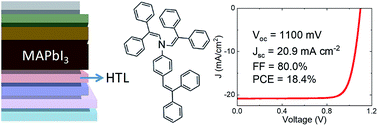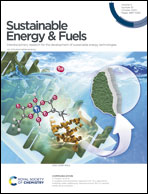Enamine-based hole transporting materials for vacuum-deposited perovskite solar cells†
Abstract
In a short period of time, the rapid development of perovskite solar cells attracted a lot of attention in the science community with the record for power conversion efficiency being broken every year. Despite the fast progress in power conversion efficiency there are still many issues that need to be solved before starting large scale commercial applications, such as, among others, the difficult and costly synthesis and usage of toxic solvents for the deposition of hole transport materials (HTMs). We herein report new enamine-based charge transport materials obtained via a simple one step synthesis procedure, from commercially available precursors and without the use of expensive organometallic catalysts. The developed materials demonstrated rapid loss of mass during thermogravimetry analysis suggesting that they could be processed not only using solution processing but also via vacuum deposition. Furthermore, all HTMs demonstrated high charge carrier mobility with H2 possessing the highest mobility of 2.5 × 10−2 cm2 V−1 s−1 under strong electric fields. The investigated materials were employed in vacuum-deposited p–i–n perovskite solar cells and champion devices with enamine H2 demonstrate a PCE of 18.4%.



 Please wait while we load your content...
Please wait while we load your content...